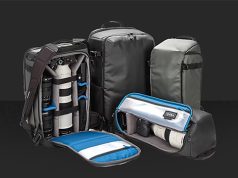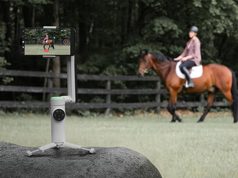It might seem odd to return to PMA show news this late in the season, but I have a feeling that a lot of fascinating tech news might have gotten lost in the shuffle, or rather the barrage, of new products that came our way. While some of this news grabbed headlines back in March, much of it might have been lost in the continuing onslaught of change that has become so much a part of our industry. Besides, some of the products announced then are just coming into stores now, so I thought a brief refresher course might be in order. Oddly, the place where much of this new tech plays a part is in digicams, archaically referred to as “point and shoot” digital cameras.
“Connectedness” has become an increasingly attractive catchphrase, one that the camera phone tried to plug into. It did, but not necessarily in the way labs had hoped for. It seems more useful for connecting one camphone to another, or catching comedians making career-ending comments in comedy clubs. Increasingly, the camphone image goes directly to the Web, which today seems the preferred destination for images made by the younger generation.
But e-mailing or swapping images direct from the camera, which began somewhat sluggishly in 2006, has been bumped up a notch with two items—file sharing between cameras, a la music downloads, and something dubbed “Connect 2 Wi-Fi.” The former is found in Sony’s new Cyber-shot DSC-G1, a “wireless photo sharing” setup. Compatible with DLNA devices to come (that’s the Digital Living Network Alliance for those not up on their acronyms), the system allows for sending an image from one camera to another, or to “future” printers, PCs and even camphones. Said to have a greater range than Bluetooth, this setup is not intended for e-mailing, but one can see future photo swapping parents using it to share images of the kids to grandma’s camera or for downloading without wires from anywhere in the house. The e-mail option is more applicable to Nikon’s new Coolpix S50c, which adds greater potential in sending images to an e-mail address from any open hotspot, and even in uploading directly from the memory card to one’s own album space on a Nikon secure server while on the road.
Images on the Move
In short, the image is becoming more transportable, with movement between various devices becoming faster and with wider range than ever before. We have all sorts of signals racing around us, particularly in this cell phone crazed world; now, you never know when an image will be flying past you as you walk down the street. This might mean “total coverage,” as Hunter Thompson used to quip, at events like weddings and birthday parties, where after the event all the photographers can swap their images before they even get their car brought out by the valet. We are certainly overwhelmed by information in every aspect of our lives. Add to that the hundreds of images “circles” of swappers will create and we will be swimming in more pictures than we might possibly be able to absorb. Ah, progress.
What about getting images “fixed” prior to downloading, to a computer or whatever device one desires? The introductions on the software side at this show seem to imply that everyone can’t wait to get their images into their computer to play with exposure, color and apply special effects. But the trend in digicams is just the opposite, playing into the techno-phobia of most folks who are truly mystified by the digital darkroom’s potential and who could care less about all that jazz. In fact, the vast majority of casual shooters might not have to bring their images into that mysterious world to get good quality results. They can shoot, do a quick fix in-camera, and dutifully bring their memory cards (or simply download wirelessly) to a kiosk for prints.
And speaking of wireless, we might also see the end of the memory card and associated card reader and wires one might use to get the images to the computer. The new Sony Cyber-shot DSC-G1 has an incredible 1.86GB of internal memory, matching the needs of what one person shooting JPEG might bring along on a weeklong trip. The camera also features an on-board image management and search function, which means that direct download puts all the images into proper folders all set up and ready to go.
Changing image attributes like contrast, saturation sharpness is old hat; now, even these rudimentary fixes and enhancements are built into Scene modes that, once chosen, apply a set of image characteristics to portraits, landscapes, etc. In olden times these modes might have prioritized various depth of field or exposure effects; now they automatically mess with saturation and contrast as well, and even color tone when it comes to portraiture. These are done automatically by the image processor, bringing Scene modes to a whole new level.
Steadying Influence
The same goes for the newest wrinkle on steadying technology, something manufacturers have dubbed “electronic anti-shake.” This is not user-selected (heaven forbid) CCD shift or in-lens stabilization; it is utilizing faster shutter speeds via an automatic ISO boost to gain steadier shots. Think of it as “auto ISO” in reaction to lower light levels. In short, when potential shake is detected by an in-camera gyro the microprocessor raises the ISO to bring the shutter speed to or above a setting that will usually yield a steady shot. As of yet I have not heard of the “highly caffeinated” version that will boost it one step beyond what is normally accepted as a safe shutter speed. It is clever, I’ll give it that, but I am also sure that this works the image processor in the camera overtime trying to get rid of the noise from these smaller sensors at higher ISO levels.
The in-camera fixes also apply to exposure and other camera and user miscues. Nikon’s Retouch menu has already incorporated a shadow recovery algorithm that actually works quite well, and red-eye as a problem has been reduced greatly by various automatic detection and elimination processes in various models from a number of makers. HP has gone a step further with what they call their “Design Gallery,” which offers any number of creative and enhancing setups. They have outdone even themselves, however, with what they dub “pet-eye” fix, which makes for less ghostly dogs, cats and other creatures that do not fluoresce red, but green or yellow when subjected to flash.
GPS Au Go Go
Anyone who’s visited Google Earth can attest to the fascinating take it gives us on our world, and neighborhoods. When you visit these days you can actually click on various hot spots and not only view topography (and even your car in your own driveway) but images made by contributing photographers that make it a truly interactive atlas. And those visiting travel and vacation web sites can feast their eyes on images made by amateurs, along with continuous commentary on their shopping and eating adventures as part of the mix. These and even personal Web sites will become even more populated with “location-tagged” images thanks to coming GPS-enabled digicams.
Samsung has taken the lead on this with their new L74 model, which will be compatible with their own GPS module. The accessory can deliver longitude, latitude and even altitude to EXIF data; this information is melded with images during downloading, and can then be hooked up with Google Earth and other sites and software that will jump on the GPS bandwagon. The idea is that maps will be populated by icons, and that clicking on the icon will reveal the users’ images made at those coordinates.
The question is: will users be seduced by these features enough to rush out and buy one model over another? In some cases they might be viewed as encumbrances, as just one more feature to try to figure out. In others they will be transparent to users and just deliver better quality results. While some innovations are met by an increasingly jaded public with a yawn or a shrug, they are how companies now differentiate their product in an increasingly crowded field.
This Just In
Late breaking news: As this column went to press Kodak has announced another approach to sensor technology, which they preliminarily dub a “high sensitivity pattern array.” In brief, most digital camera sensors (aside from the Foveon RGB layered approach) are of the Bayer pattern type, with an array of red, green and blue “filters” covering the grayscale sensor. The new sensor, expected to see consumer camera manifestation in 2008, removes some of the filters to allow the photons to strike directly on the grayscale sensor as well as the usual pass through of the RGB filters. In essence, this “separates” the exposure into luminance (brightness) and chrominance (color) signals, allowing for less noise at higher ISO settings via an expected 2X gain in sensitivity. It parallels, said a Kodak spokesperson, the gains made in consumer film over the years where higher ISO films delivered the quality of previous lower speed emulsion. We’ll stay tuned on this one. yy





